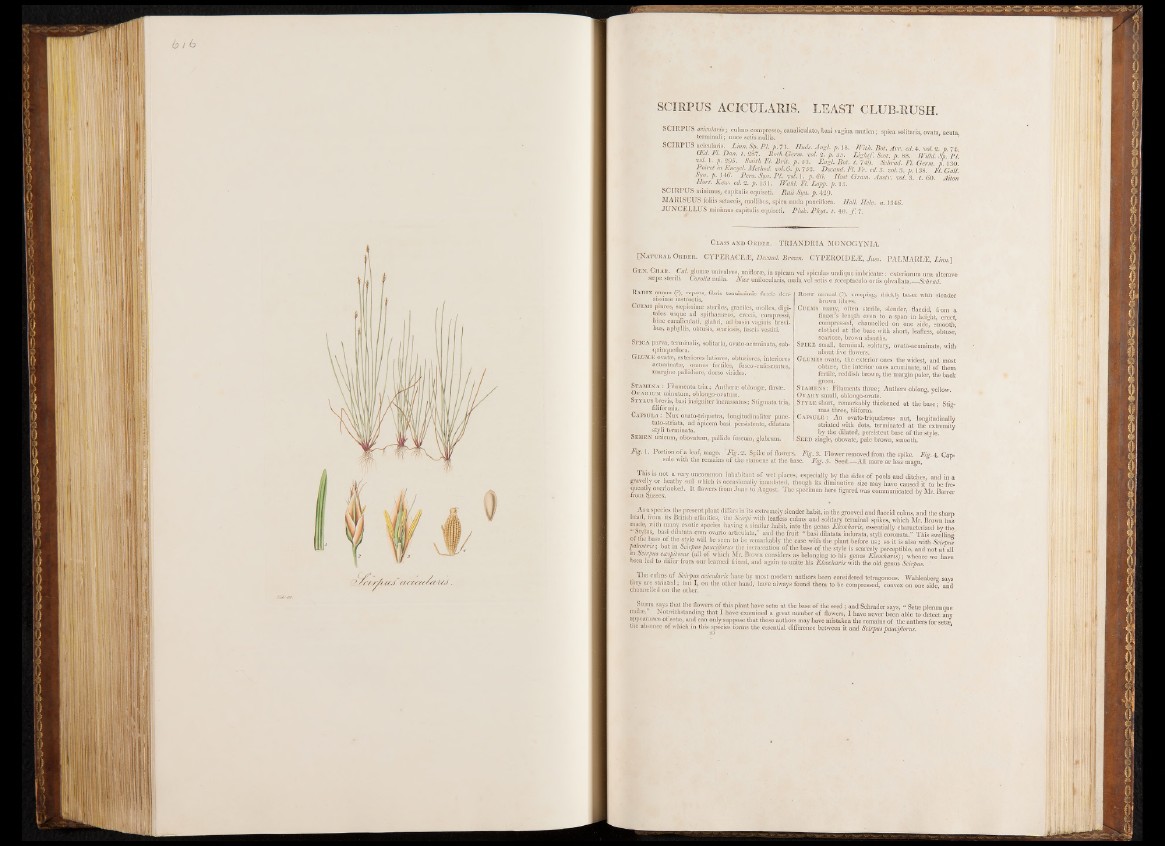
SCIRPUS ACICULARIS. LEAST CLUB-RUSIL
« , ^-luuiu cummessu, canaueuiaro, Dasi vagina mutica; spica solitaria, ovata, acuta
terminah; nuce setis nullis:
SCIRPUS ^icul^ris. Litin. Sp. PI. p . n . lluds. Angl. p. 18. With. Bot. Arr. a l l . m l. i. 0. 74.
(Ei. II. Dan. t. 2 87. Both Germ. ml. 2. p. 55. Light/. Scot. p . 88. Witli. Sp. PI.
m l . 1 . p . 295. Smith PI. Brit. p. 51. Engl. Bot. t. 749. Sckrad. Pi. Germ. p. ISO.
fo ir c t m Encycl. Method, vol. 6. p .7 5 3 . Decand. Fl. Fr. ed.3. vol. 3. p. 138. FI. Gall.
Syn. p } 46. Pers. Syn. P l. vol. i. p. 66. Host Gram. Austr. vol. 3. t. 60. Alton
'Hort. K m . ed.3. p. 131. Wahl.Fl. Lapp. p . 15.
SCIRPUS minimus, capitulis equiseti. Rail Syn. p . 420.
MAR1SCUS foliis setaceis} mollibus, spica nuda pauciflora. Hall. Helv. n. 1346.
JUNCELLUS minimus capitulis equiseti. Pluk. P h y t. t. 40. f . 7 .
Class and Order. TRIANDRIA MONOGYNIA.
[Natural Order. CYPERACEiE, Decand. Broom. CYPEROIDEiE, Juss. PALMARLE, Linn.]
Gen. Char. Cal. glumee univalves, unifloree, in spicam vel spiculas undique imbricate : exteriorum una alterave
sajpe sterili. Corolla nulla. Nu.v unilocularis, nuda vel setis e receptaculo ortis obvallata.—Schrdd.
Radix annua (?), repens, fibris tenuissimis fuscis den-
sissime instructis.
Culmi plures, Stepissime steriles, graciles, molles, digi-
■ tales usque ad spitharmeos, erecti, compressi,
hinc canaTiculati, glabri, ad basin vaginis brevi-
bus, aphyllis, obtusis, scariosis,'fuscis vestiti.
Spica parva, terminals, solitaria, ovato-acuminata, sub-
quinqueflora.
GLUMiE -ovate, exteriores latiores, obtusiores, interiores
acuminate, omnes ferfciles, fusco- rufescentes,
' inargine pallidiore, dorso virides.
Stamina: Pi I amenta tria; Antheros oblongfe, flavie.
Ovarium minutum, oblongo-ovatum.
Stylus brevis, basi insigniter incrassatus: Stigmata tria,
filiformia.
Capsula : Nux ovato-ti'iquetra, longitudinaliter punc-
tato-striata, ad apicem basi persistente, dilatata j
- styli terminata.
Semen unicum, ob’ovatum, pallide fuscum, glabrum.
Fig. 1. Portion o f a leaf, magn. 'Fig. 3. Spike of flowers
' sule with the remains o f tlie stamens at the b
This is not a very uncommon inhabitant of wet place
gravelly or heathy soil which is occasionally inundated,
quently overlooked. It flowers from June to August. The
from Sussex.
Root annual (?), creeping, thickly beset with slender
brown fibres.
Culms many, often sterile, slend.er, flaccid, from a
finger’s length even to a span in height, erect,
compressed, channelled on one side, smooth,
clothed at the base with short, leafless, obtuse,
scariose, brown sheaths.
Spike small, terminal, solitary, ovato-acuminate, with
about five flowers.
Glumes ovale, the exterior ones the widest, and most
obtuse^ the interior ones acuminate, all of them
fertile, reddish brown, the margin paler, the back
• green.
Stamens : Filaments three; Anthers oblong, yellow.
Ovary small, oblongo-ovate.
. Style short, remarkably thickened at the base; Stigmas
three, filiform.
Capsule : An ovato-triquetreus nut, longitudinally
striated with dots, terminated at the extremity
by the dilated, persistent base o f the style.
Seed single, obovate, pale brown, smooth.
• Fig. 3- Flower removed from the spike. Fig. 4. Cap-;
ise. Fig. 5. Seed.—All more* or less magn.
i, especially by the sides o f pools and ditches, and in a
hough its diminutive size may have caused it to be fre-
specimen here figured was communicated by Mr. Borrer
As a species the present plant differs in its extremely slender habit, in the grooved and flaccid culms, and the sharp
head, from its British affinities, the Scirpi with leafless culms and solitary terminal spikes, which Mr Brown h i .
made, with many exotic species having a similar habit, into the genus Eleocharis, essentially characterized by the
stylus, basi dilatata cum ovano articulata,” and the fruit “ basi dilatata indurata, styli coronata.” This swelling
of the base of the style will be seen to be remarkably the case with the plant before us; so it is also with Scirpus
palustris; but in Scirpus paucijlorus the iucrassation of the base of the style is scarcely perceptible, and not at all
in bcirpus ccespitosus (all of which Mr. Brown considers as belonging to his genus Eleocharis) ; whence we have
been led to differ from our learned friend, and again to unite his Eleocharis with the old genus Scirpus. '
l^ iThe culms of Scirpus acicularis have by most modern authors been considered tetragonous.
Wahlenberg says
they are striated; but I, on the other hand, have always found them to be compressed, convex
channelled ;on the other.
on one side, and
Sturm says that the flowers of this plant have sete at the base of the seed; and Schrader says, “ Sete plerumque
nulte. Notwithstanding that I have examined a great number o f flowers, I have never been able to detect any
appearance ofsette, and can only suppose that these authors may have mistaken the remains of the anthers for sete
me absence of which in this species forms the essential difference between it and Scirpus pauciflorus.